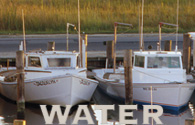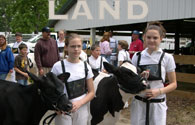Crops
Why so much corn? Vineyards on the Eastern Shore?
What is hay anyway?
Corn is the biggest crop in Chesapeake Country - that is, measured by the number of acres harvested each year. Most of what you see
along the road is field corn, used primarily as livestock feed.
The bushy green plants are soybeans, which are grown mostly for poultry feed. Soybeans add nitrogen to the soil and increase its
fertility, so most farmers rotate it with other crops. Wheat, hay, ad barley are also major crops.
A stop at a local farmers market or produce stand quickly reveals the diversity of crops grown here - from apples to melons to
zucchini.
The Tale of Two Corns: Sweet & Field

A buttered ear of corn, that's sweet corn. But 99% of corn acres are field corn, a grain that is harvested when the kernels are dry
and fully mature. Sweet corn is spicked when the plants are gree and the kernels sweet and tender. How can you tell the difference in the
field? Field corn is usually taller, has bigger leaves and stems, and its tassels are less feathery.
Make Hay While the Sun Shines
A round bale of hay weighs 500 to 2,000 lbs; a small square bale weighs 40-60 lbs. Hay is grasses alfalfa or a mixture of the two. Hay
fields are mowed when the plants are green and are most nutritious. Hay is used for forage. Straw is dried stems and stalks, what farmers
call “residue” from small grains such as sheat, rye or barley. Straw is used for bedding.



